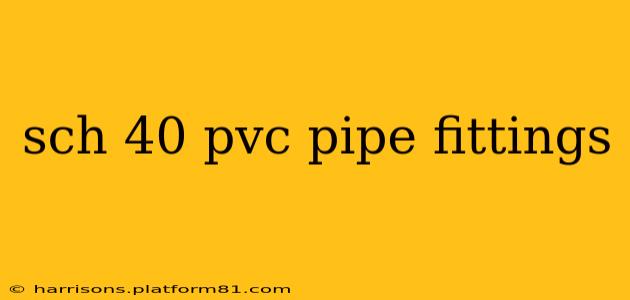PVC (polyvinyl chloride) pipes are ubiquitous in various applications, from residential plumbing to industrial chemical handling. Within the PVC piping system, Schedule 40 (SCH 40) fittings play a crucial role, offering a robust and reliable solution for connecting pipes and controlling fluid flow. This comprehensive guide delves into the world of SCH 40 PVC pipe fittings, exploring their characteristics, applications, and considerations for selection and installation.
What are SCH 40 PVC Pipe Fittings?
SCH 40 PVC pipe fittings are components used to join, redirect, or control the flow of fluids within a PVC piping system. The "Schedule 40" designation refers to the pipe's wall thickness, indicating its pressure rating and strength. Compared to thinner schedules like SCH 80, SCH 40 offers a balance between cost-effectiveness and durability, making it suitable for a wide range of applications. These fittings are typically manufactured from rigid PVC, ensuring resistance to corrosion, chemicals, and degradation.
They come in a vast array of types, each designed for a specific purpose:
- Elbows: Used to change the direction of the pipe. Available in various angles, such as 45-degree and 90-degree elbows.
- Tees: Create a branching point in the piping system, allowing for multiple connections.
- Couplings: Connect two pipes of the same diameter.
- Adapters: Connect pipes of different diameters.
- Caps: Seal the end of a pipe.
- Reducers: Gradually reduce the pipe diameter.
- Unions: Allow for the disconnection and reconnection of pipes without cutting.
What are the Advantages of using SCH 40 PVC Pipe Fittings?
SCH 40 PVC pipe fittings boast several advantages that contribute to their widespread use:
- Corrosion Resistance: PVC is inherently resistant to corrosion, making it ideal for applications involving corrosive chemicals or saltwater.
- Chemical Resistance: PVC is resistant to a wide range of chemicals, ensuring the longevity of the piping system even when handling aggressive substances.
- Lightweight: Compared to metal pipes, PVC is significantly lighter, simplifying handling and installation.
- Cost-Effective: Generally, PVC pipes and fittings are less expensive than their metal counterparts.
- Ease of Installation: PVC fittings are relatively easy to install, often requiring only solvent welding or threading, depending on the type of fitting.
What are the Different Types of SCH 40 PVC Fittings?
Beyond the basic types listed above, SCH 40 PVC fittings come in various configurations to suit diverse needs:
- Solvent Weld Fittings: These fittings are joined using a solvent cement, creating a strong, leak-proof connection. This is the most common type for SCH 40 PVC.
- Threaded Fittings: These fittings use threads for connection, offering a more reusable connection option.
- Compression Fittings: These fittings use compression rings to create a seal, offering a quick and easy connection method.
What are the Applications of SCH 40 PVC Pipe Fittings?
The versatility of SCH 40 PVC fittings makes them suitable for a broad range of applications, including:
- Residential Plumbing: Water supply lines, drainage systems.
- Irrigation Systems: Distributing water to crops or landscaping.
- Chemical Processing: Handling various chemicals in industrial settings.
- Industrial Wastewater Treatment: Moving wastewater through treatment processes.
- Swimming Pool Systems: Circulating water in swimming pools and spas.
How do I Choose the Right SCH 40 PVC Fittings?
Selecting the appropriate SCH 40 PVC fittings involves considering several factors:
- Pipe Diameter: Ensure the fittings match the diameter of the pipes being connected.
- Application: The type of application will dictate the necessary fittings (e.g., elbows for changes in direction, tees for branching).
- Pressure Rating: The pressure rating of the fittings must meet or exceed the expected pressure within the system.
- Chemical Compatibility: Ensure the fittings are compatible with the chemicals being handled.
- Installation Method: Choose fittings compatible with your chosen installation method (solvent welding, threading, etc.).
How to Install SCH 40 PVC Pipe Fittings?
Installing SCH 40 PVC fittings typically involves solvent welding for solvent weld fittings. This process requires specific steps to ensure a leak-proof connection. Always consult the manufacturer's instructions and relevant safety guidelines before commencing installation. Improper installation can compromise the integrity of the entire system.
What is the difference between SCH 40 and SCH 80 PVC pipe?
The main difference lies in the wall thickness. SCH 80 has a thicker wall than SCH 40, resulting in a higher pressure rating and increased strength. While SCH 80 provides superior pressure resistance, SCH 40 offers a cost-effective solution for applications with lower pressure demands. The choice depends on the specific project requirements and pressure considerations.
This comprehensive guide provides a solid foundation for understanding SCH 40 PVC pipe fittings. Remember to always prioritize safety and consult relevant codes and regulations during selection and installation. By understanding the nuances of these fittings, you can ensure the reliability and longevity of your PVC piping system.
